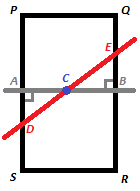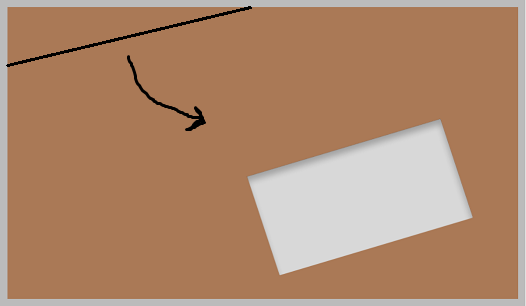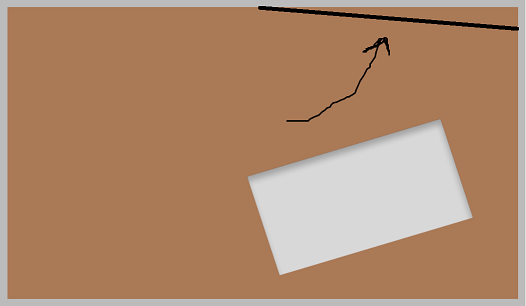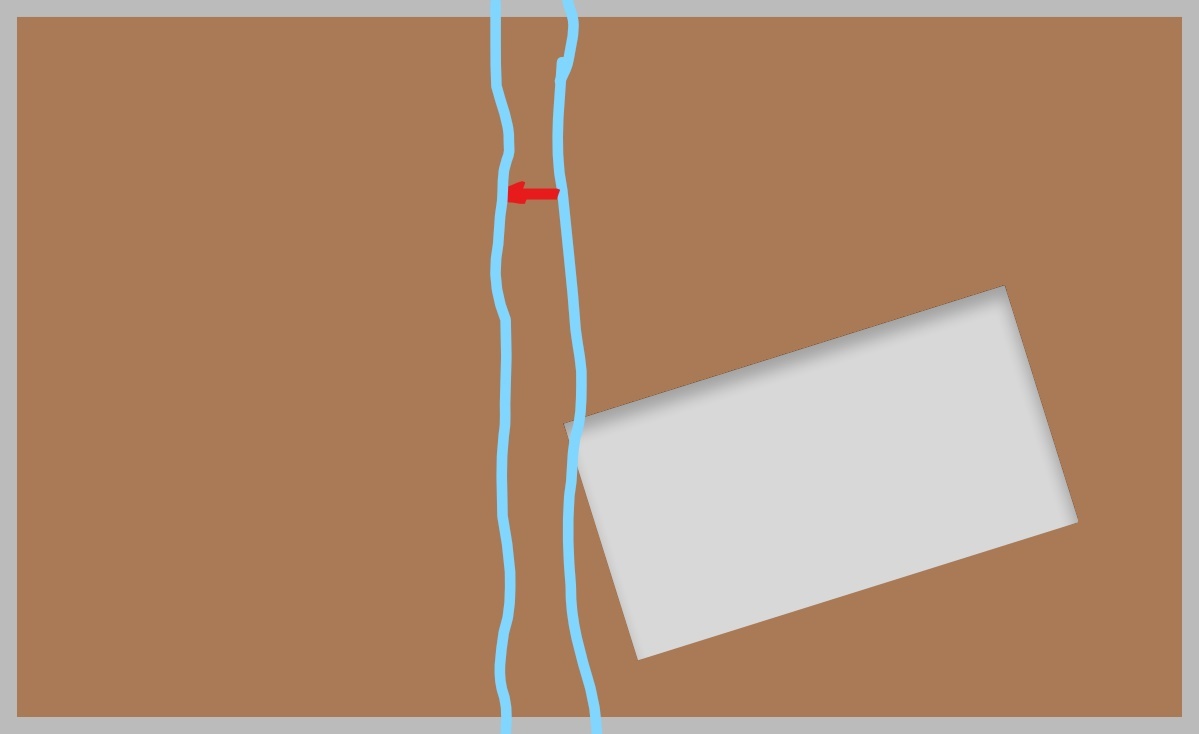Brownie cut problem
After letting my large rectangular brownie cool, I found someone had cut a smaller rectangular piece out of the middle. What's worse, they didn't bother to cut it parallel to the sides of the pan!
Is it possible to use a single straight cut to split the remaining brownie into two pieces of equal areas?
Note: The cut can pass through the already cut portion but must be done only from above.
This section requires Javascript.
You are seeing this because something didn't load right. We suggest you, (a) try
refreshing the page, (b) enabling javascript if it is disabled on your browser and,
finally, (c)
loading the
non-javascript version of this page
. We're sorry about the hassle.
16 solutions
Moderator note:
Note the property of an arbitrary line passing through the centroid cutting always cutting a shape into equal areas is not generally true. The property holds if and only if the figure is 180 degree symmetric. (Why?)
This is a nice approach indeed. To play the devil's advocate, how do you know that a line passing through the centroid actually bisects the rectangle?
Log in to reply
Let D E be any line through a rectangle P Q R S 's centroid C , where D and E are the intersection points with the rectangle, and let A B be the the line through the rectangle's centroid C , where A and B are the perpendicular bisectors of the the sides of rectangle, which makes the area of rectangle P Q B A equal to the area of rectangle A B R S

Then ∠ A C D ≅ ∠ B C E by vertical angles, A C ≅ B C by definition of centroid, and ∠ D A C ≅ ∠ E B C by right angles, which means △ A C D ≅ △ B C E by ASA.
Since the triangles are congruent, they have the same areas, and since P Q E D = P Q B A − △ E B C + △ A C D , P Q E D = P Q B A , which means that trapezoid P Q E D is half the area of rectangle P Q R S . By symmetry, trapezoid D E R S is also half the area of rectangle P Q R S , which means D E cuts rectangle P Q B A 's area in half.
Log in to reply
That's quiet detailed. Thanks!
Log in to reply
@Agnishom Chattopadhyay – Cool. Can I apply this without proof?
Then if E lies on PQ, the same proof applies using the perpendicular bisectors of PQ and SB instead? Is this the most elegant proof?
Um, you cut it that way?
As Zain Majumder implies, the proof relies on the mean value theorem. To sketch one proof, consider any line through the centroid of any closed, plane figure. Then resort to the definition of the centroid of any plane figure:
Centroid, From Wikipedia, the free encyclopedia In mathematics and physics, the centroid is the geometric center of a plane figure. It is the arithmetic mean position of all the points in the shape. The locus of those points, i.e., any line through the centroid, must then cut the shape into two equal halves in area.
Log in to reply
I don't see your logic.
Physically, the centroid is the point about which the net torque is zero. This is not the same as the mass being equal on both sides of a line through the centroid unless you have an additional property for either that figure or that line.
It is true that any figure of finite area (perhaps only in a non-atomic measure sense, and it need not be bounded) can be split into two equal halves by a line, and the proof relies on the intermediate value theorem, but this is completely removed from the concept of centroids (which in the unbounded case may not even exist).
Or tldr for the small sliver of people who like analogies and probability: Centroid is to mean as "equal area on both sides of the line" is to median. In an arbitrary distribution there is no reason the mean and median should be equal.
Log in to reply
Thanks for the mean vs median analogy. Very helpful! It was great to make that connection.
Again, I refer you to the same article and ask you to use the math or geometric definition given there. Your confusion is to use the physics or engineering definition. I quote the article and ask you to grant the uniform density, uniform thickness assumption.
"In mathematics and physics, the centroid or geometric center of a plane figure is the arithmetic mean position of all the points in the figure. Informally, it is the point at which a cutout of the shape could be perfectly balanced on the tip of a pin."
"While in geometry the term barycenter is a synonym for centroid, in astrophysics and astronomy, barycenter is the center of mass of two or more bodies that orbit each other. In physics, the center of mass is the arithmetic mean of all points weighted by the local density or specific weight. If a physical object has uniform density, then its center of mass is the same as the centroid of its shape. "
If you can balance the cutout shape at its centroid, then any line through that cutout's centroid cuts the area into equal halves. Same goes for the brownie portion. So, a line through both centroids must, then, cut the entire rectangular brownie into equal halves.
Log in to reply
If you can balance the cutout shape at its centroid, then any line through that cutout's centroid cuts the area into equal halves.
That is false unless the shape has 180 degree rotational symmetry (aka "symmetry about a point").
You keep on quoting Wikipedia but even in your own quotation it says the centroid is the arithmetic mean of the positions of the points in the figure, not the [for the lack of a better word] 2d geometric analogue of the median, which usually doesn't even exist. It's a fairly common misconception to misidentify the mean and median, and as best I can tell, this is your current misconception.
But we don't have to stop there: we can use a concrete example to investigate. Just try the simplest example of a 2d figure without 180 degree rotational symmetry: an equilateral triangle with vertices on the unit circle. Then the origin is the centroid but any line through the origin and not through a vertex of the triangle will not split the triangle into equal areas.
Moderator, I refer you to the Bounded Region section of https://en.wikipedia.org/wiki/Centroid#Bounded_region which holds for any integral boundary functions.
I don't understand. How do you know that the line passing through the bigger rectangles centroid also passes through the centroid of the smaller rectangle?
Log in to reply
You find both then cut a line that passes through both.
You could also simply find the area of the left over brownie and figure in the half amount creating multiple different cuts that completely exclude the hole from one of the brownies while still making that particular piece appear smaller even though they have the same area.
Log in to reply
By multiple different cuts I mean a single different cut in different instances of cutting the left over brownie not multiple at one time
Yes, you can cut the brownie evenly this is because you would have to take the cut area and cut it in half diagonally from the upper left area which would cause the brownie to be even on both sides.
The question would admit only this solution (and not the more general “intermediate value theorem” solution described by Zain Majumder), if you required finding a specific solution using only a straightedge and knife.
Using the straightedge, one can mark diagonals of both rectangles, and then connect their centers.
Relevant wiki: Intermediate Value Theorem

Consider a cut starting from the center top of the rectangle that cuts the left piece much smaller than the right piece. If we rotated our knife counterclockwise and tried again, additional area is given to the left piece and some is taken away from the right piece. We can continue rotating the knife all the way until the knife is pointed towards the right:

The right piece has lost so much area that the left piece is much bigger than it. Somewhere in the middle of our rotating, the right piece must have lost the exact amount of area for the right piece and the left piece to be equal.
This solution assumes the area function is continuous. The are some starting points to your 'windshield wiper' idea that will have discontinuities (8 that I can see).
Log in to reply
Yeah, I wrote this up pretty quickly and realized this afterward. You would need to prove that there is a continuous function, and at that point the solution would be much messier than David Vreken's.
Log in to reply
Yours was my first thought as well. It then reminded me of an old Dudeny type problem where we'd be required to actually find a slice that works. So I went and reasoned out David's solution too.
It's still just a matter of rigor though, right? Since we know we can cut parallel to the sides and not run into discontinuities (the one thing we know is the hole isn't parallel).
This solution (which is similar to mine) is more generalizable to irregular shapes. You could free hand cut a shape and this proof will provide a solution.in any 2D plane.
Log in to reply
@Kurt Schwind – As long as you are very careful about potential discontinuities in the area function. A very interesting question is whether there is some irregular shape that is impossible to solve with a sweeping cut.
The area function is pretty obviously continuous. As the change in angle approaches 0, the change in area also approaches 0. Is that not rigorous enough?
Why would it be discontinuous? I think the area function is continuous.. Otherwise you will have a point or line with non-zero (positive or negative) area..
I think the dissenters are correct. The area function is continuous, it's the derivative that may have a discontinuity.
Are you sure that those points give out disctionuous functions? I think that the area function is still continuous, while its derivative is not, so the indermediate value should work regardless
Log in to reply
Actually, I think you're right. I'm deleting the note due to the number of people who think this solution is fine.
This is the Ham-Sandwich theorem for two dimensions
You can do a similar thing starting with a slice at and parallel to the left edge, sliding the knife to the right and keeping it parallel. The area of the Left piece will be a continuous function of the distance to the edge of the pan, and thus must take on all values between 0% and 100% of the remaining area of the cake, so it will take on a value of 50% at some point. (And yes, the area function when rotating about a point is continuous as well, regardless of where the point is on any edge of the cake...it is the derivative of the area that is non-continuous.)
translate the rectangle wherever you want .(Translation Symmetry)
Hm, can you elaborate?
Log in to reply
The proof above this one by Zain indicates that it doesn't matter which rectangle (or possibly even the shape) someone cut out, there's always a cut you can make that divides the brownie in 2 equal parts. (All that is required, is that as you increase the angle of the cut, theta, the area of one of the sections increases while the other decreases. For theta=0 and theta=a quarter turn, one area is that of the whole rectangle (with the pice missing. The difference is, which piece is greater has swapped, from the one left of the cut being bigger, to the one to the right of the cut (if you're cutting from the upper left corner, and increasing theta by going counterclockwise). Based on the assumption of continuity, there's a value of theta where the two values are equal in the range.)
He could also mean, that if you find the solution line, you can slide the rectangle along it in either direction without changing the problem.
Log in to reply
To be clear, I was asking to elaborate on how "translation symmetry" could be used to answer this problem.
I agree with Zain's intermediate value theorem approach.
He means,you can move the rectangle any way you want as long it is within the brownie boundary
Let's say that you have a knife. Note that if you have the knife on one side of the pan, 1 0 0 % of the brownie will be on one side of the knife, and if the knife is on the other side, 1 0 0 % of the brownie will be on the other side. This means that if you move the knife from the starting position to the end position, there will always be one cut of the knife that splits the brownie into two pieces with equal area. Furthermore, if you rotate the knife, you will cut the brownie at a different angle, and since you can rotate the knife in infinitely different ways, there are actually an infinite number of ways to divide the brownie into two equal area sections.
We think the brownie is even thickness and density. So, if you can balance the pan on the edge of the counter, the same mass (and area) are on the counter and off the counter. There is certain to be many ways to balance the pan over the straight edge of a counter, and each is a solution,with the counter edge lying along the cut.
I think that there is a small issue with this logic. The farther the mass is away from the balance point, the torque will increase. With the mass being distributed unevenly, the distance from the balance point cannot equal out.
 If the brownie wasn't hollow cutting through exactly its axis of symmetry would give us equal sides.
Performing this in the current status would end up with two sides, the right of which lacking a certain area.
In order to somehow abolish the area difference, we just have to move the spot of the cutting a little bit to the left, thus creating a big enough gap that will retrieve the difference. We finally got alike sizes. (The enclosed figure is not to scale just an edited illustration!)
If the brownie wasn't hollow cutting through exactly its axis of symmetry would give us equal sides.
Performing this in the current status would end up with two sides, the right of which lacking a certain area.
In order to somehow abolish the area difference, we just have to move the spot of the cutting a little bit to the left, thus creating a big enough gap that will retrieve the difference. We finally got alike sizes. (The enclosed figure is not to scale just an edited illustration!)
You just need to cut a line through the centre point of the whole brownie and the rectangle from the empty space.
Imagine a line that passes over the pan. In the beginnnig, the whole pan is on one side of the line, and in the end, the whole pan is one the other side. As the line is moving, on one side of it, the brownie slice is getting bigger and bigger. On the other side, the slice is getting smaller and smaller. Therefore, a cut can surely be made that satisfies the criteria.
I like this problem because it has brownies in it! P.S. I don't care if this isn't a solution I just wanted to comment((growling) or so my friend says. XD)
- Although this is not practical, you could also slice the brownie in two parts like a sandwich. :)
When we keep our knife to the extreme left the ratio of areas is 0:100(left:right) and when we keep our knife to the extreme left we get 100:0 so there must be some cut whic. Could split it into 50:50
You use your brain to work this one out
3 words : Ham sandwich theory
1) Lets pretend we cut verticaly 1cm from the left edge; then the right part is mutch bigger.
2) Now pretend that we cut verticaly 1cm from the right edge; now the left side is mutch bigger.
When we "slide" the cut from position 1 to position 2 there always be a cut where the left and the right side are equal!
But wait, there is more:
you can do this methode in every angel you want! So there are infinite numbers to cut the cake in 2 equal peaces. (there are even more ways if you put in the angel of the knife you will cut (perpendicular to the cake, parrallel ore in an angle))
Imagine that the pan is in third dimension, si, we just need to cut it in the middle.
The cut passing through the centres of the 2 rectangles
Relevant wiki: Calculating Center of Mass of Mass Distributions
Any line that passes through the centroid of a rectangle cuts the rectangle into two equal parts. Therefore, a straight cut that passes through the centroid of the rectangular pan and through the centroid of rectangular cutout piece will cut both rectangles into two equal parts, which will make both brownie pieces have the same areas, equal to one half the area of the pan minus one half the area of the cutout piece.
Since a line can always be made between two points, it is always possible to split the remaining brownie into two pieces of equal area, no matter where the rectangular cutout piece is or how it is orientated.